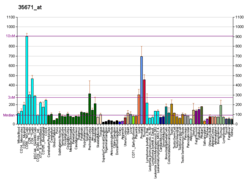GTF3C1
General transcription factor 3C polypeptide 1 is a protein that in humans is encoded by the GTF3C1 gene.[5][6][7]
Interactions
References
- 1 2 3 GRCh38: Ensembl release 89: ENSG00000077235 - Ensembl, May 2017
- 1 2 3 GRCm38: Ensembl release 89: ENSMUSG00000032777 - Ensembl, May 2017
- ↑ "Human PubMed Reference:".
- ↑ "Mouse PubMed Reference:".
- ↑ Lagna G, Kovelman R, Sukegawa J, Roeder RG (May 1994). "Cloning and characterization of an evolutionarily divergent DNA-binding subunit of mammalian TFIIIC". Mol. Cell. Biol. 14 (5): 3053–64. doi:10.1128/mcb.14.5.3053. PMC 358673. PMID 8164661.
- ↑ L'Etoile ND, Fahnestock ML, Shen Y, Aebersold R, Berk AJ (Apr 1994). "Human transcription factor IIIC box B binding subunit". Proc. Natl. Acad. Sci. U.S.A. 91 (5): 1652–6. doi:10.1073/pnas.91.5.1652. PMC 43221. PMID 8127861.
- ↑ "Entrez Gene: GTF3C1 general transcription factor IIIC, polypeptide 1, alpha 220kDa".
- ↑ Hsieh YJ, Kundu TK, Wang Z, Kovelman R, Roeder RG (Nov 1999). "The TFIIIC90 subunit of TFIIIC interacts with multiple components of the RNA polymerase III machinery and contains a histone-specific acetyltransferase activity". Mol. Cell. Biol. 19 (11): 7697–704. doi:10.1128/mcb.19.11.7697. PMC 84812. PMID 10523658.
Further reading
- Jang KL, Collins MK, Latchman DS (1992). "The human immunodeficiency virus tat protein increases the transcription of human Alu repeated sequences by increasing the activity of the cellular transcription factor TFIIIC". J. Acquir. Immune Defic. Syndr. 5 (11): 1142–7. PMID 1403646.
- Kovelman R, Roeder RG (1992). "Purification and characterization of two forms of human transcription factor IIIC". J. Biol. Chem. 267 (34): 24446–56. PMID 1447193.
- Wang Z, Roeder RG (1998). "DNA topoisomerase I and PC4 can interact with human TFIIIC to promote both accurate termination and transcription reinitiation by RNA polymerase III". Mol. Cell. 1 (5): 749–57. doi:10.1016/S1097-2765(00)80074-X. PMID 9660958.
- Loftus BJ, Kim UJ, Sneddon VP, Kalush F, Brandon R, Fuhrmann J, Mason T, Crosby ML, Barnstead M, Cronin L, Deslattes Mays A, Cao Y, Xu RX, Kang HL, Mitchell S, Eichler EE, Harris PC, Venter JC, Adams MD (1999). "Genome duplications and other features in 12 Mb of DNA sequence from human chromosome 16p and 16q". Genomics. 60 (3): 295–308. doi:10.1006/geno.1999.5927. PMID 10493829.
- Hsieh YJ, Kundu TK, Wang Z, Kovelman R, Roeder RG (1999). "The TFIIIC90 subunit of TFIIIC interacts with multiple components of the RNA polymerase III machinery and contains a histone-specific acetyltransferase activity". Mol. Cell. Biol. 19 (11): 7697–704. doi:10.1128/mcb.19.11.7697. PMC 84812. PMID 10523658.
- Meissner W, Thomae R, Seifart KH (2002). "The activity of transcription factor IIIC1 is impaired during differentiation of F9 cells". J. Biol. Chem. 277 (9): 7148–56. doi:10.1074/jbc.M108721200. PMID 11741993.
- Zhan Y, Hegde R, Srinivasula SM, Fernandes-Alnemri T, Alnemri ES (2002). "Death effector domain-containing proteins DEDD and FLAME-3 form nuclear complexes with the TFIIIC102 subunit of human transcription factor IIIC". Cell Death Differ. 9 (4): 439–47. doi:10.1038/sj.cdd.4401038. PMID 11965497.
- Weser S, Riemann J, Seifart KH, Meissner W (2003). "Assembly and isolation of intermediate steps of transcription complexes formed on the human 5S rRNA gene". Nucleic Acids Res. 31 (9): 2408–16. doi:10.1093/nar/gkg345. PMC 154231. PMID 12711686.
- Beausoleil SA, Jedrychowski M, Schwartz D, Elias JE, Villén J, Li J, Cohn MA, Cantley LC, Gygi SP (2004). "Large-scale characterization of HeLa cell nuclear phosphoproteins". Proc. Natl. Acad. Sci. U.S.A. 101 (33): 12130–5. doi:10.1073/pnas.0404720101. PMC 514446. PMID 15302935.
- Beausoleil SA, Villén J, Gerber SA, Rush J, Gygi SP (2006). "A probability-based approach for high-throughput protein phosphorylation analysis and site localization". Nat. Biotechnol. 24 (10): 1285–92. doi:10.1038/nbt1240. PMID 16964243.
- Olsen JV, Blagoev B, Gnad F, Macek B, Kumar C, Mortensen P, Mann M (2006). "Global, in vivo, and site-specific phosphorylation dynamics in signaling networks". Cell. 127 (3): 635–48. doi:10.1016/j.cell.2006.09.026. PMID 17081983.
- Dumay-Odelot H, Marck C, Durrieu-Gaillard S, Lefebvre O, Jourdain S, Prochazkova M, Pflieger A, Teichmann M (2007). "Identification, molecular cloning, and characterization of the sixth subunit of human transcription factor TFIIIC". J. Biol. Chem. 282 (23): 17179–89. doi:10.1074/jbc.M611542200. PMID 17409385.
External links
- GTF3C1+protein,+human at the US National Library of Medicine Medical Subject Headings (MeSH)
This article incorporates text from the United States National Library of Medicine, which is in the public domain.
This article is issued from
Wikipedia.
The text is licensed under Creative Commons - Attribution - Sharealike.
Additional terms may apply for the media files.





